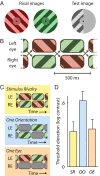A monocular contribution to stimulus rivalry
- PMID: 23610414
- PMCID: PMC3666721
- DOI: 10.1073/pnas.1305393110
A monocular contribution to stimulus rivalry
Abstract
When corresponding areas of the two eyes view dissimilar images, stable perception gives way to visual competition wherein perceptual awareness alternates between those images. Moreover, a given image can remain visually dominant for several seconds at a time even when the competing images are swapped between the eyes multiple times each second. This perceptual stability across eye swaps has led to the widespread belief that this unique form of visual competition, dubbed stimulus rivalry, is governed by eye-independent neural processes at a purely binocular stage of cortical processing. We tested this idea by investigating the influence of stimulus rivalry on the buildup of the threshold elevation aftereffect, a form of contrast adaptation thought to transpire at early cortical stages that include eye-specific neural activity. Weaker threshold elevation aftereffects were observed when the adapting image was engaged in stimulus rivalry than when it was not, indicating diminished buildup of adaptation during stimulus-rivalry suppression. We then confirmed that this reduction occurred, in part, at eye-specific neural stages by showing that suppression of an image at a given moment specifically diminished adaptation associated with the eye viewing the image at that moment. Considered together, these results imply that eye-specific neural events at early cortical processing stages contribute to stimulus rivalry. We have developed a computational model of stimulus rivalry that successfully implements this idea.
Keywords: ambiguous stimuli; binocular rivalry; bistable perception; flicker-and-swap rivalry.
Conflict of interest statement
The authors declare no conflict of interest.
Figures




Similar articles
-
When your brain decides what you see: grouping across monocular, binocular, and stimulus rivalry.Psychol Sci. 2005 Jul;16(7):516-9. doi: 10.1111/j.0956-7976.2005.01566.x. Psychol Sci. 2005. PMID: 16008782
-
Image-based and eye-based influences on binocular rivalry have similar spatial profiles.J Vis. 2017 Oct 1;17(12):14. doi: 10.1167/17.12.14. J Vis. 2017. PMID: 29071351
-
Removal of monocular interactions equates rivalry behavior for monocular, binocular, and stimulus rivalries.J Vis. 2008 Nov 24;8(15):13.1-17. doi: 10.1167/8.15.13. J Vis. 2008. PMID: 19146297
-
Single units and conscious vision.Philos Trans R Soc Lond B Biol Sci. 1998 Nov 29;353(1377):1801-18. doi: 10.1098/rstb.1998.0333. Philos Trans R Soc Lond B Biol Sci. 1998. PMID: 9854253 Free PMC article. Review.
-
How does binocular rivalry emerge from cortical mechanisms of 3-D vision?Vision Res. 2008 Sep;48(21):2232-50. doi: 10.1016/j.visres.2008.06.024. Epub 2008 Aug 13. Vision Res. 2008. PMID: 18640145 Review.
Cited by
-
Serial correlations in Continuous Flash Suppression.Neurosci Conscious. 2015 Dec 31;2015(1):niv010. doi: 10.1093/nc/niv010. eCollection 2015. Neurosci Conscious. 2015. PMID: 30619623 Free PMC article.
-
Stimulus rivalry and binocular rivalry share a common neural substrate.J Vis. 2018 Sep 4;18(9):18. doi: 10.1167/18.9.18. J Vis. 2018. PMID: 30372752 Free PMC article.
-
Eye swapping temporally modulates potency of continuous flash suppression.J Vis. 2020 Mar 17;20(3):1. doi: 10.1167/jovi.20.3.1. J Vis. 2020. PMID: 32181857 Free PMC article.
-
Cholinergic Modulation of Binocular Vision.J Neurosci. 2020 Jul 1;40(27):5208-5213. doi: 10.1523/JNEUROSCI.2484-19.2020. Epub 2020 May 26. J Neurosci. 2020. PMID: 32457075 Free PMC article.
-
Perceptual rivalry across animal species.J Comp Neurol. 2020 Dec 1;528(17):3123-3133. doi: 10.1002/cne.24939. Epub 2020 Jun 1. J Comp Neurol. 2020. PMID: 32361986 Free PMC article. Review.
References
-
- Blake R, Logothetis N. Visual competition. Nat Rev Neurosci. 2002;3(1):13–21. - PubMed
-
- Logothetis NK, Leopold DA, Sheinberg DL. What is rivalling during binocular rivalry? Nature. 1996;380(6575):621–624. - PubMed
-
- Tong F, Meng M, Blake R. Neural bases of binocular rivalry. Trends Cogn Sci. 2006;10(11):502–511. - PubMed
-
- Pearson J, Tadin D, Blake R. The effects of transcranial magnetic stimulation on visual rivalry. J Vis. 2007;7(7):2.1–2.11. - PubMed
Publication types
MeSH terms
Grants and funding
LinkOut - more resources
Full Text Sources
Other Literature Sources

